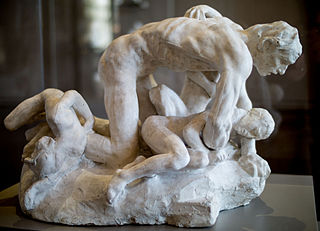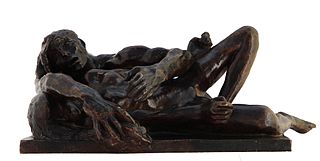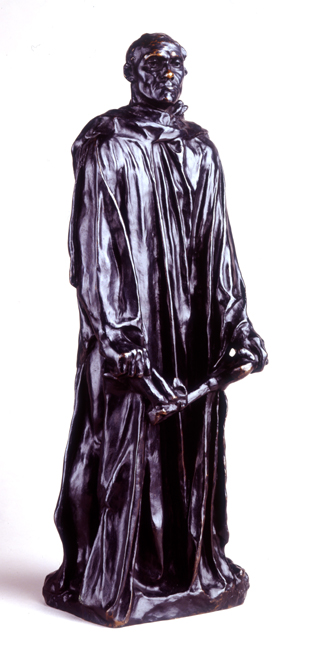
Camille Rosalie Claudel was a French sculptor known for her figurative works in bronze and marble. She died in relative obscurity, but later gained recognition for the originality and quality of her work. The subject of several biographies and films, Claudel is well known for her sculptures including The Waltz and The Mature Age.

The Thinker is a bronze sculpture by Auguste Rodin, usually placed on a stone pedestal. The work depicts a nude male figure of heroic size sitting on a rock. He is seen leaning over, his right elbow placed on his left thigh, holding the weight of his chin on the back of his right hand. The pose is one of deep thought and contemplation, and the statue is often used as an image to represent philosophy.

The Burghers of Calais is a sculpture by Auguste Rodin in twelve original castings and numerous copies. It commemorates an event during the Hundred Years' War, when Calais, a French port on the English Channel, surrendered to the English after an eleven-month siege. The city commissioned Rodin to create the sculpture in 1884 and the work was completed in 1889.

The Kiss is an 1882 marble sculpture by the French sculptor Auguste Rodin. The embracing nude couple depicted in the sculpture appeared originally as part of a group of reliefs decorating Rodin's monumental bronze portal The Gates of Hell, commissioned for a planned museum of art in Paris. The couple were later removed from the Gates and replaced with another pair of lovers located on the smaller right-hand column.

The Gates of Hell is a monumental bronze sculptural group work by French artist Auguste Rodin that depicts a scene from the Inferno, the first section of Dante Alighieri's Divine Comedy. It stands at 6 metres high, 4 metres wide and 1 metre deep (19.7×13.1×3.3 ft) and contains 180 figures. The figures range from 15 centimetres (6 in) high up to more than one metre (3 ft). Several of the figures were also cast as independent free-standing statues.
Bernard Gerald Cantor was the founder and chairman of securities firm Cantor Fitzgerald.

The Walking Man is a bronze sculpture by the French sculptor Auguste Rodin. This sculpture was made in 1907.

The Iris & B. Gerald Cantor Center for Visual Arts at Stanford University, formerly the Stanford University Museum of Art, and commonly known as the Cantor Arts Center, is an art museum on the campus of Stanford University in Stanford, California. The museum first opened in 1894 and consists of over 130,000 sq ft (12,000 m2) of exhibition space, including sculpture gardens. The Cantor Arts Center houses the largest collection of sculptures by Auguste Rodin outside of Paris, with 199 works, most in bronze but others in different media. The museum is open to the public and charges no admission.
Iris Cantor is a New York City and Los Angeles -based philanthropist, with a primary interest in medicine and the arts. Cited as among the 50 top contributors in the United States, as head of the Iris and B. Gerald Cantor Foundation, her foundation has donated several hundred million dollars to museums, universities and hospitals since 1978.

Cybele is a sculpture by French artist Auguste Rodin. It is one of the first of Rodin's partial figures known as "fragments" to be displayed as sculpture in its own right, rather than an incomplete study.

The Falling Man is a sculpture by French artist Auguste Rodin modeled in 1882 and is part of Rodin's emblematic group The Gates of Hell.

Ugolino and his sons is a plaster sculpture by French artist Auguste Rodin, part of the sculptural group known as The Gates of Hell. As an independent piece, it was exhibited by its author in Brussels (1887), Edinburgh (1893), Genoa (1896), Florence (1897), Netherlands (1899) and in his own retrospective in 1900.

Avarice and Lust is a sculpture by French artist Auguste Rodin, conceived between 1885-1887, representing two of the seven capital sins and is part of his sculptural group The Gates of Hell, where it can be found in the lower part of the right door. It's possible that the name was inspired by Victor Hugo's poem Après une lecture du Dante:

Andromeda is a sculpture by the French artist Auguste Rodin, named after Andromeda. It is one of the sculptures produced as part of his The Gates of Hell project and appears on the left door next to the personification of Day and on the right door as part of the group showing a falling winged genius.

Glaucus is a sculpture by the French artist Auguste Rodin, first conceived in 1886 as a representation of the mythological figure Glaucus, son of Poseidon. Originally made in plaster, bronze casts of it are now in the Brooklyn Museum and the Museo Soumaya.

Jean d'Aire is a sculpture by the French artist Auguste Rodin, first conceived around 1885 as part of the planning for his group The Burghers of Calais.

Despair or Despair at the Gate is a sculpture by Auguste Rodin that he conceived and developed from the early 1880s to c. 1890 as part of his The Gates of Hell project. The figure belongs to a company of damned souls found in the nine circles of Hell described by Dante in The Divine Comedy. Other title variations are Shade Holding her Foot, Woman Holding Her Foot, and Desperation. There are numerous versions of this work executed as both plaster and bronze casts and carved marble and limestone.

Damned Women is a sculpture created by Auguste Rodin between 1885 and 1890 as part of his The Gates of Hell project—it appears on the upper right as the counterpart to The Fallen Caryatid.

Polyphemus is an 1888 sculpture by Auguste Rodin, showing Polyphemus and his love for the Nereid Galatea, as told in Book XIII of Ovid's Metamorphoses.

















